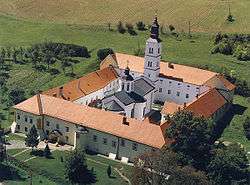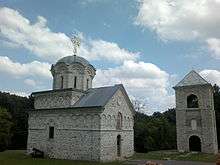Đorđe Branković
Đorđe Stefanović Branković (Serbian Cyrillic: Ђорђе Стефановић Бранковић; anglicized as George; 1461–1516) was a Serbian nobleman who was the titular Despot of Serbia. Given the title in 1486 by Matthias Corvinus, he ruled a region known as Racszag (after Rascia, being equivalent of modern Vojvodina) under the Kingdom of Hungary. From 1493, he ruled jointly with his brother Jovan, who later succeeded him when he took monastic vows (as Maksim, Serbian Cyrillic: Максим) in 1496. He built the Krušedol monastery. He was related to the House of Basarab, in particular to Neagoe Basarab.
| Đorđe Branković | |||||
|---|---|---|---|---|---|
| Serbian Despot | |||||
Stone-icon on the outer wall of the Krušedol monastery | |||||
| Despot of Serbia | |||||
| Reign | 1486–1496 | ||||
| Predecessor | Vuk Grgurević | ||||
| Successor | Jovan Branković | ||||
| Born | 1461 | ||||
| Died | 18 January 1516 | ||||
| Burial | Krušedol monastery | ||||
| Spouse | Isabella del Balzo, daughter of Agilberto, Duke of Nardò. | ||||
| |||||
| House | Branković dynasty | ||||
| Father | Stefan Branković | ||||
| Mother | Angelina Arianiti | ||||
| Religion | Serbian Orthodox Christian | ||||
Life
Đorđe was the son of Stefan Branković, Despot of Serbia 1458–1459, and Angelina Arianites.
He married Isabella del Balzo, daughter of Agilberto, Duke of Nardò (Aragon).
Vuk Grgurević died on April 16, 1485. He received the title of Despot of Serbia by Matthias Corvinus in 1486. Despot Đorđe also was given the cities of Kupinik (Kupinovo), Slankamen, and Berkasovo in Syrmia, as well as other towns which fell under these cities. From 1493, he ruled jointly with his brother Jovan, who would later succeed him as Despot. In 1494, the two brothers fought against Herzog Lovra, who had possessions in Syrmia and Slavonia. In December 1494, the brothers conquered Mitrovica, which they entrusted to their nobles. In the beginning of 1496, Đorđe took monastic vows, receiving the name Maksim, and he subsequently became the Archbishop of Belgrade. Jovan took the throne in 1496, and he had different goals than his brother Đorđe: Jovan did not seek to create a heavenly empire, but sought to defeat the Turks and drive them out of his lands, and as such be entitled the ranks of his ancestors.
He is mentioned, together with all of his family, in the "Dell'Imperadori Constantinopolitani", or Massarelli manuscript, found in the papers of Angelo Massarelli (1510–1566).[1]
Sainthood
Saint Maksim | |
|---|---|
| Saint | |
| Died | Krušedol monastery, present day Vojvodina, Serbia |
| Venerated in | Serbian Orthodox Church |
He died on 18 January 1516. A cult was made for him in 1523, in the time when Belgrade had been in Ottoman hands for two years, and when the Ottoman border had, towards the Battle of Mohács, came closer and closer to Krušedol, his endowment. He was buried there, and his cult was founded as to serve as a morale booster in the Serbs, who, together with the Hungarians, fought the powerful Ottomans. At the same time, in the same place, and with the same idea, cults of all his family were founded: His father's, Stefan Branković (1484), his mother's, Angelina (at the same time as Maksim), and his brother's, Jovan (since 1505). Krušedolac of the 16th century celebrated all members of the last family of the Branković, and biographies were written of Angelina and Maksim.
The family was buried at the Krušedol monastery and laid together in coffins at the altar. The Turks, however, burned the holy relics in 1716 after the loss at Battle of Petrovaradin, and only the left arm of Angelina and some minor body parts of other members were spared and proclaimed holy relics of the Serbian Orthodox Church.[2]
| Ancestors of Đorđe Branković | |||||||||||||||||||||||||||||||||||||||||||||||||||||||||||||||||||||||||||||||||||||||||||||||||||||||||||||||||||||||||||||||||||||||||||||||||||||||||||||||||||||||||||||||||||||||||||||||||||||||||||||||||||||||||||||||||||||||||||||||||||||||||||||||||||||||||||||||||||||||||||||||||||||||||||||||||||||||||||||||||||||||||||||||||||||||||||||||||||||||||||||||||||||||||||||||||||||||||||||||||||||||||||||||||||||||||||||||||||||||||||||||||||||||||||||||||||||||||||||||||||||||||||||||||||||||||||||||||||||||||||||||||||||||||||||
|---|---|---|---|---|---|---|---|---|---|---|---|---|---|---|---|---|---|---|---|---|---|---|---|---|---|---|---|---|---|---|---|---|---|---|---|---|---|---|---|---|---|---|---|---|---|---|---|---|---|---|---|---|---|---|---|---|---|---|---|---|---|---|---|---|---|---|---|---|---|---|---|---|---|---|---|---|---|---|---|---|---|---|---|---|---|---|---|---|---|---|---|---|---|---|---|---|---|---|---|---|---|---|---|---|---|---|---|---|---|---|---|---|---|---|---|---|---|---|---|---|---|---|---|---|---|---|---|---|---|---|---|---|---|---|---|---|---|---|---|---|---|---|---|---|---|---|---|---|---|---|---|---|---|---|---|---|---|---|---|---|---|---|---|---|---|---|---|---|---|---|---|---|---|---|---|---|---|---|---|---|---|---|---|---|---|---|---|---|---|---|---|---|---|---|---|---|---|---|---|---|---|---|---|---|---|---|---|---|---|---|---|---|---|---|---|---|---|---|---|---|---|---|---|---|---|---|---|---|---|---|---|---|---|---|---|---|---|---|---|---|---|---|---|---|---|---|---|---|---|---|---|---|---|---|---|---|---|---|---|---|---|---|---|---|---|---|---|---|---|---|---|---|---|---|---|---|---|---|---|---|---|---|---|---|---|---|---|---|---|---|---|---|---|---|---|---|---|---|---|---|---|---|---|---|---|---|---|---|---|---|---|---|---|---|---|---|---|---|---|---|---|---|---|---|---|---|---|---|---|---|---|---|---|---|---|---|---|---|---|---|---|---|---|---|---|---|---|---|---|---|---|---|---|---|---|---|---|---|---|---|---|---|---|---|---|---|---|---|---|---|---|---|---|---|---|---|---|---|---|---|---|---|---|---|---|---|---|---|---|---|---|---|---|---|---|---|---|---|---|---|---|---|---|---|---|---|---|---|---|---|---|---|---|---|---|---|---|---|---|---|---|---|---|---|---|---|---|---|---|---|---|---|---|---|---|---|---|---|---|---|---|---|---|---|---|---|---|---|---|---|---|---|---|---|---|---|---|---|---|---|---|---|---|---|---|---|---|---|---|---|---|---|---|---|---|---|---|---|---|---|---|---|---|---|---|---|---|---|---|---|---|---|---|---|---|---|---|---|---|---|---|---|---|---|---|---|---|---|---|---|---|---|---|---|---|---|---|---|---|---|---|---|---|---|---|---|---|---|---|---|---|---|---|---|---|---|---|---|---|---|---|
| |||||||||||||||||||||||||||||||||||||||||||||||||||||||||||||||||||||||||||||||||||||||||||||||||||||||||||||||||||||||||||||||||||||||||||||||||||||||||||||||||||||||||||||||||||||||||||||||||||||||||||||||||||||||||||||||||||||||||||||||||||||||||||||||||||||||||||||||||||||||||||||||||||||||||||||||||||||||||||||||||||||||||||||||||||||||||||||||||||||||||||||||||||||||||||||||||||||||||||||||||||||||||||||||||||||||||||||||||||||||||||||||||||||||||||||||||||||||||||||||||||||||||||||||||||||||||||||||||||||||||||||||||||||||||||||
Gallery
 Personal coat of arms
Personal coat of arms
 Saints Maksim, Angelina, Jovan and Stefan Branković, by Andreja Raičević (c. 1645)
Saints Maksim, Angelina, Jovan and Stefan Branković, by Andreja Raičević (c. 1645) Krušedol monastery was founded by Đorđe Branković
Krušedol monastery was founded by Đorđe Branković Staro Hopovo monastery was founded by Đorđe Branković
Staro Hopovo monastery was founded by Đorđe Branković
| Wikimedia Commons has media related to Đorđe Branković. |
References
- Tony Hoskins, "Anglocentric medieval genealogy"
- Alexandru Ioan Cuza university. Medieval and Early Modern for Central and Eastern Europe. Al I Cuza University Press. pp. 110–. GGKEY:FS32LZBL77L.
Sources
- Massarellus, Angelus. Dell'Imperadori Constantinopolitani. Codex Vaticanus Latinus 12127, fols. 349V—353 (in Latin).
- Mitrović, K. (2008). "Povelja despotice Jelene Jakšić manastiru Hilandaru". Stari srpski arhiv, no. 7, pp. 195–203 (in Serbian).
- Tubić, D. (2006). "The Branković family from Srem in historiography". Spomenica Istorijskog arhiva Srem, no. 5, pp. 232–242 (in Serbian).
- Ćirković, Sima (2004). The Serbs. Malden: Blackwell Publishing.CS1 maint: ref=harv (link)
| Regnal titles | ||
|---|---|---|
| Preceded by Vuk Grgurević |
Serbian Despot (titular) 1486–1496 |
Succeeded by Jovan Branković |
